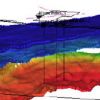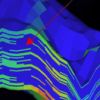PetroMod
PetroMod petroleum systems modeling software combines seismic, well, and geological information to model the evolution of a sedimentary basin. The software predicts if, and how, a reservoir has been charged with hydrocarbons, including the source and timing of hydrocarbon generation, migration routes, quantities, and hydrocarbon type in the subsurface or at surface conditions.
Large-scale geologic petroleum systems models (1D, 2D, or 3D) cover areas ranging from a single charge area for a prospect to regional studies of entire basins to multibasin resource assessments. The models are dynamic, which means they provide a complete record of the structural evolution, temperature, and pressure history, as well as the effects on generation, migration, accumulation, and loss of oil and gas in a petroleum system through geologic time. Properties such as gas/oil ratios (GOR) and API gravities can be analyzed, understood, and predicted.
Petroleum systems modeling (PSM) is a vital component of exploration risk assessment—from basin to prospect. It can be applied during all stages of exploration, from frontier basins with no well control, to well-explored areas and charge assessments of single prospects or fields. Even in producing areas, charge risk on a prospect scale is an essential component of a fully integrated risk assessment. The 3D petroleum systems model includes all the key elements of geological risk in exploration (trap, reservoir, charge, seal, and timing of hydrocarbon generation, migration, and loss) and enables rigorous risk analyses.





















